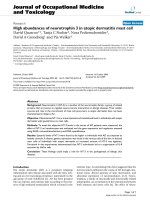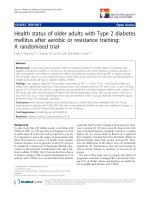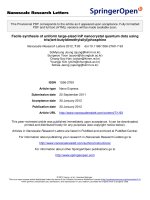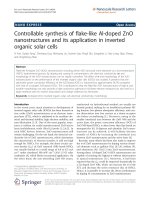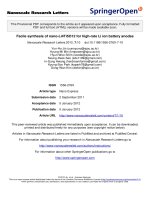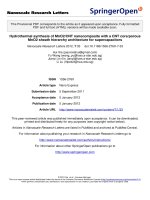Báo cáo hóa học: " Microwave-assisted synthesis of water-dispersed CdTe/CdSe core/shell type II quantum dots" pdf
Bạn đang xem bản rút gọn của tài liệu. Xem và tải ngay bản đầy đủ của tài liệu tại đây (1.08 MB, 7 trang )
NANO EXPRESS Open Access
Microwave-assisted synthesis of water-dispersed
CdTe/CdSe core/shell type II quantum dots
Li-Man Sai and Xiang Yang Kong
*
Abstract
A facile synthesis of mercaptanacid-capped CdTe/CdSe (core/shell) type II quantum dots in aqueous solution by
means of a microwave-assisted approach is reported. The results of X-ray diffraction and high-resolution
transmission electron microscopy revealed that the as-prepared CdTe/CdSe quantum dots had a core/shell
structure with high crystallinity. The core/shell quantum dots exhibit tunable fluorescence emissions by controlling
the thickness of the CdSe shell. The photoluminescent properties were dramatically improved through UV-
illuminated treatment, and the time-resolved fluorescence spectra showed that there is a gradual increase of decay
lifetime with the thickness of CdSe shell.
Introduction
Semiconducting nanocrystals such as quantum dots
(QDs) have attracted more attention due to their unique
optical properties and many potential appli cations
including nanolasers, biolabelings, and photovoltaics,
etc. [1,2]. The unique optical propertie s are featured as
narrow emission spectra, continuous absorption band,
high chemical and photobleaching stability, and surface
functi onality. To date, QDs have various nanostructured
configurations, typically as core/shell heterostructure
QDs, where two different semiconductors are incorpo-
ratedintoasinglecolloidalQD[3].TherearetypeI
and type II core/shell QDs with different carrier locali-
zations, depending on the b and structure offsets
between the semiconducting core and the shell [4].
Type I i s where both the electrons and holes are con-
fined in the core, in contrast, type II is where the elec-
trons and holes are separated between the core and the
shell, giving rise to a significant increase in the exciton
lifetime with possible applications in photovoltaics [5].
Specifically, it has been reported that the CdTe/CdSe
core/shell QDs exhibit type II band alignment facilitat-
ing charge separations upon absorption of visible light
for solar cells [6].
Recently, the high-quality CdTe/CdSe heterostructure
QDs have been successfully synthesized via colloidal
chemical routes [7-9]. However, these synthetic methods
cost several hours in an organic solvent at high tem-
perature, and the product easily performed the agglom-
eration with broad size distribution. It is desirable to
develop a facile method for fast synthesis of highly
fluorescent type II core/shell QDs in aqueous ion solu-
tion. A microwave-assisted synthesis is an attractive
method employed routinely for the synthesis of nano-
cry stals due to the advantages of the reaction selectivity
and high efficiency for obtaining the controllable pro-
ducts [10-12]. In this paper, we employed the micro-
wave-assisted synthesis in aqueous solution for the
water-dispersed CdTe/CdSe core/shell type II nanocrys-
tals. The optical properties of as-prepared CdTe/CdSe
nanocrystals can be optimized in the presence of Cd
2+
and mercaptopropionic acid by UV-illuminated treat-
ment. The photoluminescence quantum yield (PLQY) of
the as-prepared QDs was enhanced from 12% to as high
as 45%. These aqueous-d ispersed CdTe/CdSe core/shell
type II QDs may have potential applications in solar
cells.
Experimental methods
Microwave-assisted synthesis of CdTe core QDs
For monodispersed CdTe core QD synthesis, the CdTe
precursor solution was prepared by adding a freshly pre-
pared NaHTe solution to a N
2
-saturated CdCl
2
solution
in the pres ence of the stabilizer of 3-mercaptopropionic
acid (MPA). The molar ratio of Cd
2+
/MPA/HTe
-
was
set as 1:2. 5:0.2. The as-pre pared CdTe precursor solu-
tion is subjected to microwave irradiation for about 2
* Correspondence:
School of Material Science and Engineering, Shanghai Jiao Tong University,
Dongchuan Road 800, Shanghai 200240, People’s Republic of China
Sai and Kong Nanoscale Research Letters 2011, 6:399
/>© 2011 Sai and Kong; licensee Springer. This is an Open Access article di stributed under the terms of the Crea tive Commons
Attribution License ( which permits unrestricted use, distr ibution, and reproduction in
any medium, provid ed the original work is properly cited.
min at 100°C, and is naturally cooled down lower than
50°C. The CdTe core QDs stabilized with MPA were
concentrated from the solution and were precipitated
with 2-propanol by centrifugation, and then re-dissolved
in ultrapure water.
Microwave-assisted synthesis of CdTe/CdSe core/shell
QDs
The CdTe/CdSe precursor solution was prepared by
adding a certain amount of postprepared CdTe core
QDs to a N
2
-saturated solution mixed w ith CdCl
2
,
NaHSe, and MPA in pH 11.2. The concentration of Cd
2
+
was fixed at 1.25 mM. The high-quality CdTe/CdSe
QDs were prepared in a very short time, and the sizes
of the QDs were controlled on the basis of regulating
the reaction time of microwave irradiation. The samples
were taken when the temperature decreased naturally to
lower than 50°C and centrifuged for high concentration.
Structural characterizations and spectroscopic
measurements
The as-prepared QD samples were precipitated by 2-
propanol and dried in a vacuum oven for X-ray diffrac-
tion (XRD) characterization. The XRD patterns were
recorded from a Rigaku D/max-gB diffracto meter. The
samples for transmission electron microscopy (TEM)
were prepared by dropping the aqueous CdTe/CdSe
solution onto carbon-coated copper grids with the
excess solvent evaporated. The TEM images were
recorded from a JEOL JEM 2100 electron microscope
(JEOL, Tokyo, Japan) operated at 200 kV.
The UV-Vis absorption spectra were recorded with a
Shimadzu UV-3150 UV-Vis-near-infrared spectrophot-
ometer (Shimadzu Corporation, Columbia, MD, USA)
The photoluminescence (PL) measurements were per-
formed using a Shimadzu RF-6301PC spectrofluorimeter
(Shimadzu Corporation, Columbia, MD, USA). The
PLQY of QDs at room temperature was estimated using
standard method [13]. The optical density at the excita-
tion wavelength of the Rhodamine 6G (R6G) and the
QD samples in the solution were set to a similar value.
The wavelength of the excitonic absorption peak of the
QDs was set as the excitation wavelength for measure-
ment. The integrated PL intensities of the QD and R6G
were calculated from the fully corrected fluorescence
spectrum. The PLQY of the QD samples was finally
obtained by comparing the integrated PL intensities of
the QDs and R6G. The UV-illuminated treatment of the
samples was done with three UV lamps, and the inten-
sity of the illuminated light was 16 W.
Results and discussion
The typical band structure alignment of the conducti on
and valence band edges for the CdTe/CdSe core/shell
type II heterostructures is shown in Figure 1a. With
regard to the core/shell structures, the separation of the
hole and the electron can be achieved upon excitation.
The hole is mostly confined in the CdTe core while the
electron is in the CdSe shell. The as-received CdTe and
CdTe/CdSe core/shell QDs via microwave-assisted
synthesis were examined systematically from the crystal-
lography structure to the unique optical properties.
Figure 1b shows the XRD patterns of the original
CdTe cores and the corresponding CdTe/CdSe QDs.
The diffraction pattern of the bare CdTe cores is consis-
tent with that of the b ulk cubic CdTe structure, repre-
sented by the diffraction peaks at 23.5°, 39.1°, and 46.5°.
Such broad diffractive peaks are typical for the crystals
with nanoscale size. The diffraction pattern of CdTe/
CdSe QDs moves gradually toward a higher angle.
These pat tern configurations indicate clear ly the forma-
tion of heterostructure of CdTe/CdSe QDs. Similar
results in the diffraction patterns are consistent with
previous reports as well [9]. In addition, the pattern of
peak widths and shapes is nearly unchanged, which indi-
cates it should be the CdS/CdTe core/shell structure
rather than the CdTe
x
S
1-x
alloyed structure.
TEM images of the as-prepared CdTe and CdTe/CdSe
QDs are shown in Figure 1c,d, respectively. From the
low magnification image, the CdTe core QDs appear as
the size of about 2 nm spherical particles with good
monodispersity. The existence of a well-resolved lattice
fringe on the HRTEM image further confirms the crys-
talline structure of CdTe. Figure 1d illustrates a typical
CdTe/CdSe core/shell QD from different contrasts cor-
respondi ng to a CdTe core and CdSe shell, respectively.
The thickness of a CdSe shell is about four to five
atomic layers.
The optical performance of a series of original CdTe
cores and corresponding CdTe/CdSe type II QDs
synthesized at 100°C with different reaction times were
examined, as shown in Figure 2a. It shows the continu-
ous red shift in emission with the coating of CdSe shells
onto CdTe core QDs. When the reaction or coating
CdSe shell time is up to 20 min, the emission wave-
length shifted to 665 nm, with an increase of 120 nm
compared to the CdTe core QDs whose emission peak
appeared at 545 nm. The thickness of the CdSe shell is
observed as up to four or five atomic layers surrounding
the CdTe cores with a 2-nm radius. As the reaction
time increases, the CdSe shell coating proceeds and
results in longer wavelengths of the emission shift. This
clearly indicates the strong type II characteristics as the
excitons become more spatially separated by thicker
shells. Therefore, the PL peak can be assigned to an
indirect excitation, originating from the radiative recom-
bination of electron hole pairs across the core/shell
interface [14,15].
Sai and Kong Nanoscale Research Letters 2011, 6:399
/>Page 2 of 7
Lifetime measurements allow us to probe the degree
of wavelength overlap of the carriers, or the oscillator
strength of the transition. Figure 2b shows a PL decay
of a CdTe/CdSe QD sample dispersed in water. The
CdTe/CdSe QD sample with the thickest shell (about
five atomic layers) was selected for the PL decay
measurement. The CdTe and CdTe/CdSe QD solutions
are diluted to achieve the same absorbance value (0.1) at
the wavelength of their first excitation absorption peak.
As shown in Figure 2b, an increase of the decay lifetime
is observed with the increase of t he CdSe shell. It was
reported that the wave function overlap integral is
CdTe core
CdSe
shell
20 30 40 50 6
0
Intensity (a.u.)
Cu KD2T
(
O
)
CdTe
CdSe
0.65eV
1.74eV
0.34eV
VB
CB
VB
CB
h
+
e
-
excitation
CdTe
CdTe/CdSe
CdTe
CdSe
a
b
c
d
1nm
1nm
Figure 1 Band structure alignment. (a) Alignment of the conduction and valence band edges for CdTe/CdSe core/shell type II
heterostructures. (b) XRD patterns of CdTe and CdTe/CdSe core/shell QDs via microwave-assisted synthesis. The black bars at the bottom
represent the XRD pattern of bulk CdTe (cubic). The black bars at the top represent the XRD pattern of bulk CdSe (cubic). (c) TEM bright field
image of the CdTe core QDs in low magnification, the inset for the HRTEM image of CdTe QD with cubic structure. (d) HRTEM image of CdTe/
CdSe core/shell QD, different contrasts corresponding to the CdTe core and CdSe shell, respectively. The thickness of the shell is about four to
five atomic layers.
Sai and Kong Nanoscale Research Letters 2011, 6:399
/>Page 3 of 7
inversely proportional to the radiative lifetime [16], giv-
ing rise to the charge separation of the electron and
hole for longer lifetime values. This undoubtedly reveals
the type II characteristics of our CdTe/CdSe QDs
demonstrating the spatially separated excitons.
In order to obtain the appreciated properties of the as-
received core/shell QDs, the synthesis conditions were
optimized. Figure 3a shows that the wavelength shift
and PL intensity of CdTe/CdSe QDs are strongly influ-
enced by the CdTe concentration. All the CdTe/CdSe
QD solutions were diluted to a certain concentration for
the same absorbance values at the wavelength of their
first excitation absorption peak, which was also used for
the excitation of the QD samples in the PL measure-
ment. The molar ratio of [Cd
2+
]/[MPA]/[HSe
-
]wasset
as 1:2.4:1, the concentration of Cd
2+
was fixed at 1.25
mM, the reaction temperature was set at 100°C, and th e
reaction time was about 3 min. Here, we use the
absorption values at the first excitation absorption peak
of the CdTe QDs to re present the concentration of
CdTe core QDs dispersed in the CdSe precursor solu-
tion. The wavelength shift refers to the emission wave-
length difference of CdTe/CdSe core/shell QDs and
CdTe core QDs. When this concentration was small,
there would be much Se
2-
existing around each CdTe
QD, therefore resulting in the fast coating of the CdSe
shell. The wavelength shift increased with the thicker
CdSe shell. When the concen tration was too high (e.g.,
absorption value at 1.0), there would be too few Se
2-
for
shell coating, and the emission wavelength almost did
not shift. On the other hand, the PL intensity gradually
decreased with the decreasing absorption value, which
shows that fast coating will lead to a larger amount of
surface defects and thus decrease of PL intensity. In our
experiment, the proper range of CdTe absorptio n value
was set about 0.5 to 0.7.
The PL spectra of CdTe/CdSe core/shell QDs synthe-
sized with different [Cd
2+
]/[Se
2-
] molar ratio is shown in
Figure 3b. The absorption values of the CdTe core were
fixed at 0.6. The molar ratio of Cd
2+
/MPA was set as
1:2.4, and the reaction temperature and time were about
100°C and 3 min, respectively. It is shown that the emis-
sion peak of CdTe/CdSe Q Ds dramatically shifted to
longer wavelength with the increase amount of Se
2-
.
The larger amount of Se
2-
existing in the solution will
give rise to the faster coating of the CdSe shell as well
as more surface defects. The [Cd
2+
]/[Se
2-
] molar ratio is
optimized around 1:1 for good optical performance.
It is also found that the MPA stabilizer plays an
important role on the optical performance of the CdTe/
CdSe QDs. The molar ratio of [Cd
2+
]/[Se
2-
]wassetas
1:1, the absorption value of the CdTe core was fixed at
0.6, and Figure 3c shows the PL intensities of the CdTe/
CdSe QDs with different ratios of the MPA stabilizer to
Figure 2 Optical performance of CdTe cores and corresponding CdTe/CdSe type II QDs by means of microwave-assisted synthesis. The
optical performance of a series of original CdTe cores and corresponding CdTe/CdSe type II QDs by means of microwave-assisted synthesis. The
QD samples are excited at their first excitation absorption peak, and The PL intensities of all the samples are normalized. (a) Fluorescence
spectra of CdTe cores (black line) and CdTe/CdSe core/shell QDs with controlled reaction time under microwave irradiation, giving rise to the
different CdSe shell thickness surrounding the CdTe core. The molar ratio of [Cd
2+
]/[MPA]/[Se
2-
] was set as 1:2.4:1, the concentration of Cd
2+
was
fixed at 1.25 mM, reaction temperature at about 100°C, and reaction time range from 2 min to approximately 20 min. (b) Fluorescence decay
curves of a CdTe core (black line) and the CdTe/CdSe core/shell QDs (red line). The lifetimes were recorded at the maxima of the emission with
the excitation wavelength of 371 nm. The inset picture indicates the fluorescence spectra of the corresponding QDs. The decay lifetime
increases dramatically due to the coating of CdSe shell (reaction time of about 5 min under microwave irradiation).
Sai and Kong Nanoscale Research Letters 2011, 6:399
/>Page 4 of 7
the concentration of Cd
2+
. When the [MPA]/[Cd
2+
]
ratio ranged from 2.4 to 4.0, the core/shell QDs with
high PLQY were obtained in a favorable coating thick-
ness, resulting from an equilibrium coating/dissolution
between the QDs and Cd-MPA complexes [17,18]. In
the case of the [MPA]/[Cd
2+
]ratiolowerthan2.4or
higher than 4.0, it was found that the PL intensities
were decreased. The reason is accounted for the effects
of the MPA stabilizer on the QD surface or giving rise
to non-radiative defects [19]. Thus, the CdTe/CdSe QDs
exhibit a relatively good quality when the ratio of
[MPA] to [Cd
2+
] is about 1:2.4.
ItisknownthattheCdTeQDshaveagreattenseto
aggregate under the illuminated treatment of a UV lamp
[20]. The as-prepared QDs were examined by a UV
lamp (16 W) for the comparison of the photostab ility of
CdTe and CdTe/CdSe QDs. The illumination density of
all examined solutions was normalized by adjusting their
absorption values to 0.2 at the first excitation absorption
peak. Figure 3d shows the PL intensity of CdTe and
CdTe/CdSe QDs versus the illuminated treatment time.
It is shown that the PL intensity of the C dTe QDs
quickly decreased under UV treatment and almost faded
till 35 min of UV treatment. In contrast, CdTe/CdSe
QDsweremuchmorestableagainsttheUVtreatment
whose PL intensity was enhanced at the initial stage and
was held for a long time, 25 min; at 35 min, it just
dropped to its original intensity. This improvement of
the photostability of CdTe/CdSe QDs was probably due
to the protection o f the shell to prevent the oxidization
of Te
2-
on the surface of CdTe QDs, thus retained the
PL intensity [21]. The en hanced photostability of CdTe/
Figure 3 Wavelength shift and PL intensity of CdTe/CdSe core/shell QDs. The PL intensities of the as-prepared QDs solutions were
estimated from the samples diluted to a certain concentration with the same absorbance values at the wavelength of their first excitation
absorption peak. (a) Wavelength shift and corresponding PL intensity of CdTe/CdSe QDs versus different absorption values of the CdSe precursor
solution. (b) PL spectra of CdTe/CdSe core/shell QDs synthesized with different [Se
2-
]/[Cd
2+
] molar ratio. (c) PL intensity of CdTe/CdSe QDs
versus different [Cd
2+
]/[MPA] molar ratio. (d) PL intensity of CdTe and CdTe/CdSe QDs versus the UV-illuminated treatment time.
Sai and Kong Nanoscale Research Letters 2011, 6:399
/>Page 5 of 7
CdSe QDs can be an evidence of the successful forma-
tion of core/shell heterostructures.
We also perform the UV-illuminated treatment for
improving the PLQY of our as-received CdTe/CdSe
QDs. In our case, we found that the adding of 3-MPA
to the as-prepared CdTe/CdSe QD solution caused a
decrease of the PL intensity. To avo id this kind of fluor-
escence quen ching but still provide S
2-
for illumination,
we made a solution including Cd
2+
and MPA (molar
ratio [Cd
2+
]/[MPA] = 1:2.4) instead of pure MPA mole-
cule, and the PH value of the solution was adjusted to
11.2. The as-prepared CdTe/CdSe QDs were diluted to
the same concentration with the corresponding CdTe
QDs and illuminated treatment with UV lamps, and the
resultsareshowninFigure4.ItwasfoundthatthePL
intensity of the as-prepared CdTe/CdSe QDs was greatly
enhanced during illumination. After 65 min of illumina-
tion, the PL intensity of CdTe/CdSe achieved at the
highest level with the PLQY of 45%. The UV illumina-
tion provides a novel photochemical treatment approach
for the enhancement of the PLQY of the QDs. Similar
results have been reported elsewhere, such as the photo-
etching of thiol-capped CdTe [22] and the photochemi-
cal treatment of ZnSe nanocrystals [23].
Conclusions
We demonstrated a quick and low-cost approach to
synthesize the water-dispersed CdTe/CdSe type II QDs
by the microwave-assisted appr oach. The as-prepared
core/shell QDs were water-dispersed and had good
crystallinity. The PL performance can be optimized by
appropriately adjusting molar ratios of the precursors
and the reaction temperature as well as the time of
microwave irradiation. The emission wavelength was tun-
able from 530 to 680 nm by adjusting the reaction time
for the increase of shell thickness. Under the UV-illumi-
nated treatment, t he PLQY of the core/shell QDs was
enhanced to 45% in the prese nce of Cd
2+
and 3-mercap-
topropionic acid. The lifetime of the CdTe/CdSe QDs
was lasting more than that of the CdTe core QDs, which
has the potential applications as sensitizers for solar cells.
Acknowledgements
This work was financially supported by the 973 Project of China (grant no.
2010CB933702).
Authors’ contributions
All the authors contributed to writing of the manuscript. LMS carried out
the experiments under the instruction of XYK
Competing interests
The authors declare that they have no competing interests.
Received: 17 February 2011 Accepted: 27 May 2011
Published: 27 May 2011
References
1. Bruchez M, Moronne M, Gin P, Weiss S, Alivisatos AP: Semiconductor
nanocrystals as fluorescent biological labels. Science 1998, 281:2013-2016.
2. Tsutsui T: Applied physics - a light-emitting sandwich filling. Nature 2002,
420:752-755.
3. Kim S, Fisher B, Eisler HJ, Bawendi M: Type-II quantum dots: CdTe/CdSe
(core/shell) and CdSe/ZnTe(core/shell) heterostructures. J Am Chem Soc
2003, 125:11466-11467.
4. Balet LP, Ivanov SA, Piryatinski A, Achermann M, Klimov VI: Inverted core/
shell nanocrystals continuously tunable between type-I and type-II
localization regimes. Nano Lett 2004, 4:1485-1488.
5. Lo SS, Mirkovic T, Chuang CH, Burda C, Scholes GD: Emergent properties
resulting from type-II band alignment in semiconductor
nanoheterostructures. Adv Mater 2011, 23:180-197.
6. Zhong H, Zhou Y, Yang Y, Yang C, Li Y: Synthesis of type II CdTe-CdSe
nanocrystal heterostructured multiple-branched rods and their
photovoltaic applications. The Journal of Physical Chemistry C 2007,
111:6538-6543.
7. Xia YS, Zhu CQ: Aqueous synthesis of type-II core/shell CdTe/CdSe
quantum dots for near-infrared fluorescent sensing of copper(II). Analyst
2008, 133:928-932.
8. Zeng RS, Zhang TT, Liu JC, Hu S, Wan Q, Liu XM, Peng ZW, Zou BS:
Aqueous synthesis of type-II CdTe/CdSe core-shell quantum dots for
fluorescent probe labeling tumor cells. Nanotechnology 2009,
20(9):095102.
9. Zhang Y, Li Y, Yan XP: Aqueous layer-by-layer epitaxy of type-II CdTe/
CdSe quantum dots with near-infrared fluorescence for bioimaging
applications. Small 2009, 5:185-189.
10. Gerbec JA, Magana D, Washington A, Strouse GF: Microwave-enhanced
reaction rates for nanoparticle synthesis. J Am Chem Soc 2005,
127:15791-15800.
11. Dallinger D, Kappe CO: Microwave-assisted synthesis in water as solvent.
Chem Rev 2007, 107:2563-2591.
12. Zhu MQ, Gu Z, Fan JB, Xu XB, Cui J, Liu JH, Long F: Microwave-mediated
nonaqueous synthesis of quantum dots at moderate temperature.
Langmuir 2009, 25:10189-10194.
13. Qu LH, Peng XG: Control of photoluminescence properties of CdSe
nanocrystals in growth. J Am Chem Soc 2002, 124:2049-2055.
14. Li JJ, Tsay JM, Michalet X, Weiss S: Wavefunction engineering: from
quantum wells to near-infrared type-II colloidal quantum dots
CdTe
CdTe/CdSe
Figure 4 Results of UV illumination treatment of the as-
prepared CdTe/CdSe core/shell QDs. PL spectra of CdTe/CdSe
QDs after UV treatment, which indicates that the PL intensity of the
CdTe/CdSe QDs could be enhanced by the lasting time of UV
illumination. The PL intensities of the as-prepared CdTe/CdSe QDs
were recorded at the same absorbance values at the first excitation
the absorption peak.
Sai and Kong Nanoscale Research Letters 2011, 6:399
/>Page 6 of 7
synthesized by layer-by-layer colloidal epitaxy. Chem Phys 2005,
318:82-90.
15. Xie RG, Zhong XH, Basche T: Synthesis, characterization, and
spectroscopy of type-II core/shell semiconductor nanocrystals with ZnTe
cores. Adv Mater 2005, 17:2741-2745.
16. Efros AL: Luminescence polarization of CdSe microcrystals. Physical Review
B 1992, 46:7448.
17. Guo J, Yang WL, Wang CC: Systematic study of the photoluminescence
dependence of thiol-capped CdTe nanocrystals on the reaction
conditions. J Phys Chem B 2005, 109:17467-17473.
18. Zhang H, Wang LP, Xiong HM, Hu LH, Yang B, Li W: Hydrothermal
synthesis for high-quality CdTe nanocrystals. Adv Mater 2003,
15:1712-1715.
19. Borchert H, Talapin DV, Gaponik N, McGinley C, Adam S, Lobo A, Moller T,
Weller H: Relations between the photoluminescence efficiency of CdTe
nanocrystals and their surface properties revealed by synchrotron XPS. J
Phys Chem B 2003, 107:9662-9668.
20. Gaponik N, Talapin DV, Rogach AL, Hoppe K, Shevchenko EV, Kornowski A,
Eychmuller A, Weller H: Thiol-capping of CdTe nanocrystals: an alternative
to organometallic synthetic routes. J Phys Chem B 2002, 106:7177-7185.
21. Talapin DV, Mekis I, Gotzinger S, Kornowski A, Benson O, Weller H: CdSe/
CdS/ZnS and CdSe/ZnSe/ZnS core-shell-shell nanocrystals. J Phys Chem B
2004, 108:18826-18831.
22. Bao HB, Gong YJ, Li Z, Gao MY: Enhancement effect of illumination on
the photoluminescence of water-soluble CdTe nanocrystals: Toward
highly fluorescent CdTe/CdS core-shell structure. Chem Mater 2004,
16:3853-3859.
23. Shavel A, Gaponik N, Eychmuller A: Efficient UV-blue photoluminescing
thiol-stabilized water-soluble alloyed ZnSe(S) nanocrystals. J Phys Chem B
2004, 108:5905-5908.
doi:10.1186/1556-276X-6-399
Cite this article as: Sai and Kong: Microwave-assisted synthesis of
water-dispersed CdTe/CdSe core/shell type II quantum dots. Nanoscale
Research Letters 2011 6:399.
Submit your manuscript to a
journal and benefi t from:
7 Convenient online submission
7 Rigorous peer review
7 Immediate publication on acceptance
7 Open access: articles freely available online
7 High visibility within the fi eld
7 Retaining the copyright to your article
Submit your next manuscript at 7 springeropen.com
Sai and Kong Nanoscale Research Letters 2011, 6:399
/>Page 7 of 7


